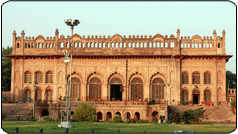Maqbara of Amzad Ali Shah / Imambara Sibtainabad
Hazrat gunj was the city's focus of attention this month, with the recently concluded carnival. Nevermind the numerous events organised, there was no mention of its original founder and the fact that his tomb lay barely a stone's throw away.
It was the tenth Nawab, the fourth King of Awadh, Abu Zafar Suraiya Jah, Mirza Amjad Ali Shah who ascended the throne of Awadh in May 1842, and built the posh market of Hazrat gunj in the newly developed eastern part of the city.
He was influenced by Sultan-ul-Ulema Maulana Syed Mohammed, the son of Maulana Dildar Ali Naqvi, posthumously titled Ghufran Maab, and was overtly inclined towards his faith. Considering his religious bent of mind, the King was popularly addressed as Hazrat Saheb, hence the market built by him took the name, Hazrat gunj. He also built a palace close to Hazrat gunj for one of his queens [which was named Kothi Sultan Inayat, for being a gift by the Sultan or King. It was later known as Begum Kothi]. It was later destroyed during the British rule [and now has the Janpath Market].
Amjad AN Shah also completed the construction of the Iron Bridge, the idea of which was mooted during the reign of the sixth Nawab, Saadat Ali Khan (1798-1814). The construction of the pucca road connecting Lucknow and Kanpur was also completed during his reign. Amjad Ali Shah maintained a special police force for patrolling on this road which was infested with highway robbers and thugs who waylaid travellers.
The construction of Imambara Sibtainabad [named as such by the King for holding majlis and mourning the martyrdom of Imam Hussain] was commenced by Amjad Ali Shah and was completed by his son Wajid Ali Shah when he ascended the throne in 1847. The place where the flat-roofed structure was built was earlier the chhavni (cantonment) of Mendu Khan who also had a serai (inn) in its vicinity.
The Imambara was surrounded on all four sides by two enclosures with gateways at the middle of the ghulam gardish, which are arched cloisters meant for attendants. [The outer enclosure encircled the inner one]. Only two of these gateways, one on the front, opposite the Halwasiya market and the other at the entrance of the Imambara are extant today. The palaces and other large buildings of the earlier Nawabs, such as Noor Bakhsh palace and Noor Manzil were located closeby and there is no reason why there would not have been another gateway (on the rear) towards Lai Bagh as well.
A mosque was attached to the maqbara and Maulvi Amir Ali, the leader of the Muslims in the dispute of Hanuman Garhi at Ayodhya. stayed in this mosque while he was at Lucknow on the invitation of King Wajid Ali Shah, for holding a dialogue to resolve the issue.
The Imambara structure was later referred to as maqbara, for bearing the mortal remains of King Amjad Ali Shah. It also has the grave of one of his grandsons, Mirza JavedAli and the grave of Najm-un-Nissan Begum, a queen of Wajid Ali Shah, who was formally addressed as Aashiq Mahal.
The structure was under attack and occupied by Sikh troops of the British army on March 13, 1858, on their way to the assault on Begum Hazrat Mahal and her loyal freedom fighters at Qaiser Bagh, that finally led to the recapture of Lucknow.
The Archaeological Survey of India (A.S.I.) has done an excellent job in restoring part of the main Imambara structure in its control, in the form of a hall with decorated archways and indication of graves within it [which actually lie below, in the basement]. However, the wings on both sides of the hall are still under unauthorised occupation and both the ghulam gardish have been put to use as shops and residences with the connivance of the Lucknow Development Authority.
Source:
Hindustan Times, City Scan, A Time in History
Wednesday 27.5.1998 — Maqbara Sibtainabad

